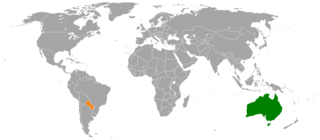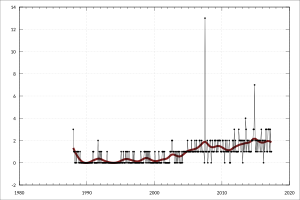
A diplomatic mission or foreign mission is a group of people from a state or organization present in another state to represent the sending state or organization officially in the receiving or host state. In practice, the phrase usually denotes an embassy or high commission, which is the main office of a country's diplomatic representatives to another country; it is usually, but not necessarily, based in the receiving state's capital city. Consulates, on the other hand, are smaller diplomatic missions that are normally located in major cities of the receiving state. As well as being a diplomatic mission to the country in which it is situated, an embassy may also be a nonresident permanent mission to one or more other countries.

A consul is an official representative of a government who resides in a foreign country to assist and protect citizens of the consul's country, and to promote and facilitate commercial and diplomatic relations between the two countries.

A consulate is the office of a consul. A type of diplomatic mission, it is usually subordinate to the state's main representation in the capital of that foreign country, usually an embassy. The term "consulate" may refer not only to the office of a consul, but also to the building occupied by the consul and the consul's staff. The consulate may share premises with the embassy itself.

The Embassy of Finland to the Commonwealth of Australia is Finland's diplomatic mission in Canberra, Australia. The mission is also accredited to New Zealand, Fiji, Papua New Guinea, Samoa, Tonga, Vanuatu and the Solomon Islands. As it is the only Finnish Embassy in the Southern Pacific region (Oceania), in practice the embassy also represents Finland in its relations with other Pacific island states in the region.

Diplomatic relations between Australia and Ukraine were established in 1992. Ukraine has had an embassy in Canberra since March 2003 and the Australian Embassy in Kyiv was established in December 2014, however, Australia closed its embassy in Kyiv in February 2022 due to the 2022 Russian invasion of Ukraine.

The Embassy of Australia in Moscow is the diplomatic mission of Australia to the Russian Federation. The current head of post and Ambassador of Australia to the Russian Federation is John Geering. The embassy serves as the diplomatic mission for Australia to the Russian Federation, Armenia, Belarus, Kazakhstan, Kyrgyzstan, Tajikistan, Turkmenistan and Uzbekistan. The chancery is located at 10A/2 Podkolokolny Lane in the Tagansky District of Moscow.

Foreign relations exist between Australia and Switzerland. Switzerland opened a consulate in Sydney in 1855 and one in Melbourne in 1856. Both countries established diplomatic relations in 1961. Switzerland has an embassy in Canberra, a consulate-general in Sydney and 6 honorary consulates in Adelaide, Brisbane, Darwin, Hobart, Melbourne and Perth. In November 2022, Australia opened an embassy in Bern and maintains a consulate-general in Geneva.

Foreign relations exist between Australia and Estonia. Australia first recognised Estonia on 22 September 1921. Australia was among the first countries to re-recognise Estonia's independence on 27 August 1991. Both countries re-established diplomatic relations on 21 November 1991.

Foreign relations are present between Australia and Finland. Diplomatic relations were established on 31 May 1949. Australia is represented in Finland through its embassy in Stockholm, Sweden, and through an honorary consulate in Helsinki. Finland has had an embassy in Canberra since 1978, alongside honorary consulate generals in Melbourne and Perth, honorary consulates in Adelaide, Brisbane, Darwin, Hobart, and Sydney, and an honorary vice-consulate in Cairns.

Bilateral relations exist between Australia and Paraguay. Diplomatic relations were established in 1974. Paraguay has an embassy in Canberra whilst Australia has a non resident ambassador in Buenos Aires. Both countries are members of the Cairns Group.

The Embassy of Greece in Canberra is the main diplomatic mission of the Hellenic Republic in Australia, and residence of the Greek Ambassador to Australia; it is currently located in the suburb of Yarralumla, a suburb in which most of Canberra's embassies are found.

Foreign relations exist between Australia and Latvia. Australia first recognised Latvia on 22 September 1921 and was among the first countries to re-recognise Latvia's independence on 27 August 1991. Both countries re-established diplomatic relations on 21 November 1991. Australia is represented in Latvia through its embassy in Stockholm, Sweden and an honorary consulate in Riga. Latvia has had an embassy in Canberra since October 2021, and also has honorary consulates in Sydney, Brisbane, Adelaide, Melbourne and Perth.
















